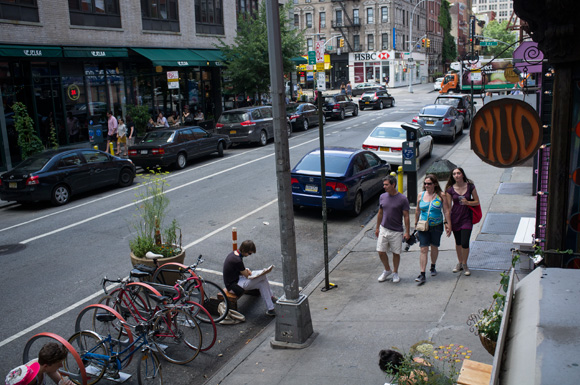The East Village and Lower East Side have seen new bike infrastructure flourish in the past few years, and now have some of the best city bicycling infrastructure in the country, including what will soon be the nation’s longest protected bike lanes on First and Second Avenues, several on-street bike corrals, and, coming next spring, bike-share stations blanketing the neighborhood.
The effects of these projects don’t go unnoticed. After a few years of living with streets that are safer for biking and walking, business owners have come to embrace the redesigns and appreciate their widespread benefits – calmer motor vehicle traffic, more space for pedestrians, and better visibility for all. To date, over 150 businesses, theaters, galleries, and community organizations in the East Village and Lower East Side have joined New York City’s first Bike Friendly Business District, and more are signing up every day.
When I started as an intern at Transportation Alternatives’ Bike Friendly Business program, the first business owner I spoke to was Doug Jaeger. Doug is the curator of JsX55, a gallery located on the Clinton Street bike lane in the Lower East Side. He kept thanking me for taking the time to help him request a bike rack and offered to hand out bike safety information to his customers. His response was typical of most business owners I’ve spoken to since.
Veselka’s Tom Birchard is effusive about all the bicyclists rolling by who stop in for a snack at his restaurant. “I never could have anticipated how great having bike lanes outside of Veselka would be,” Tom told me recently. “Thousands of people see my store every day that never would have before the lane went in.”
Janelle Kilmer, one of the owners of Bluestockings Bookstore, appreciates that the new bike corral outside the shop provides 10 parking spots for bicyclists in a space that previously only fit one car. “The corral has made our store even more appealing for the dozens of customers who get here by bike,” she said. “And having a row of bikes where huge trucks used to double-park means more customers can see our storefront.”
Research backs these observations up. Transportation Alternatives’ East Village Shoppers Study [PDF], a snapshot of travel and spending patterns in the East Village released earlier this month, found that 73 percent of people in the East Village said the protected bike lanes on First Avenue and Second Avenue had a positive or very positive impact on the community.
The bike network in the East Village and Lower East Side is a boon for more than bicyclists. This infrastructure makes these neighborhoods safer for pedestrians too. Bike lanes and refuge islands give more street space to pedestrians, slow down traffic and make streets more vibrant and inviting. NYC DOT data reveals that implementing such features can reduce traffic injuries by up to 50 percent for everyone on the street.
The New Yorkers who are attracted to the improved conditions on these streets add real value to the local economy. According to the survey responses, the average person who walks or bikes to the neighborhood visits more often than the average driver and spends more money there. Bike lanes mean business and savvy business owners know it.






